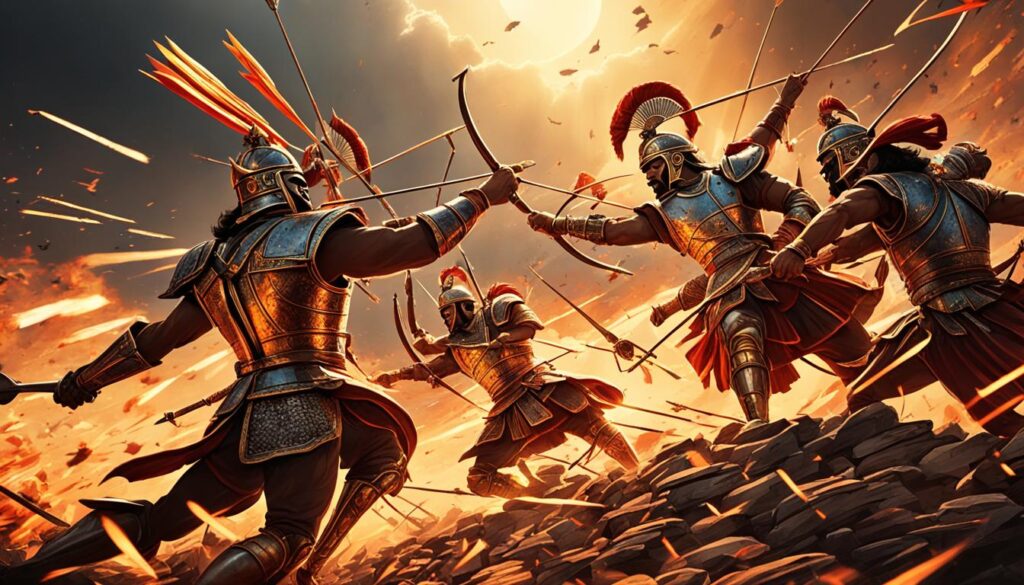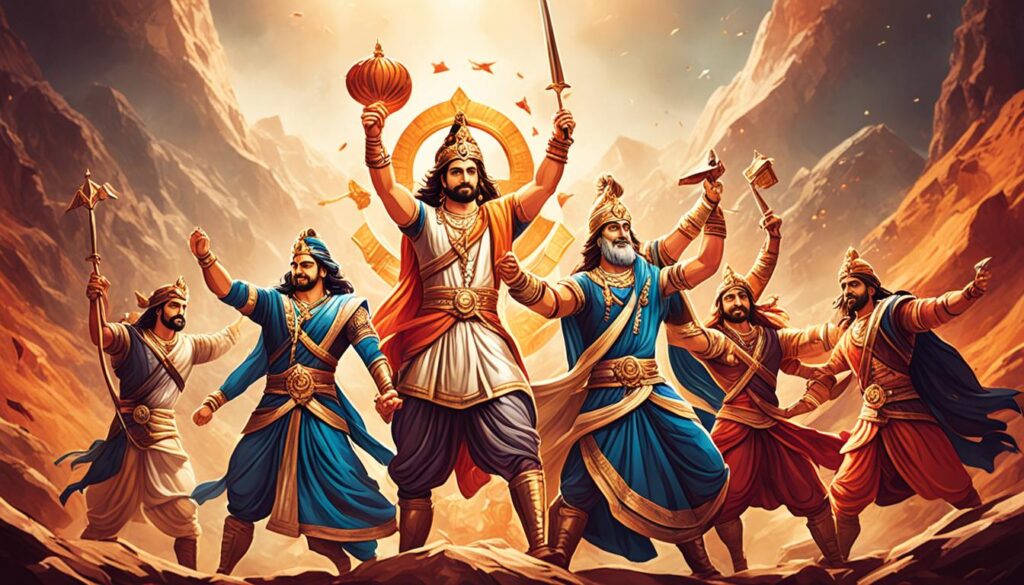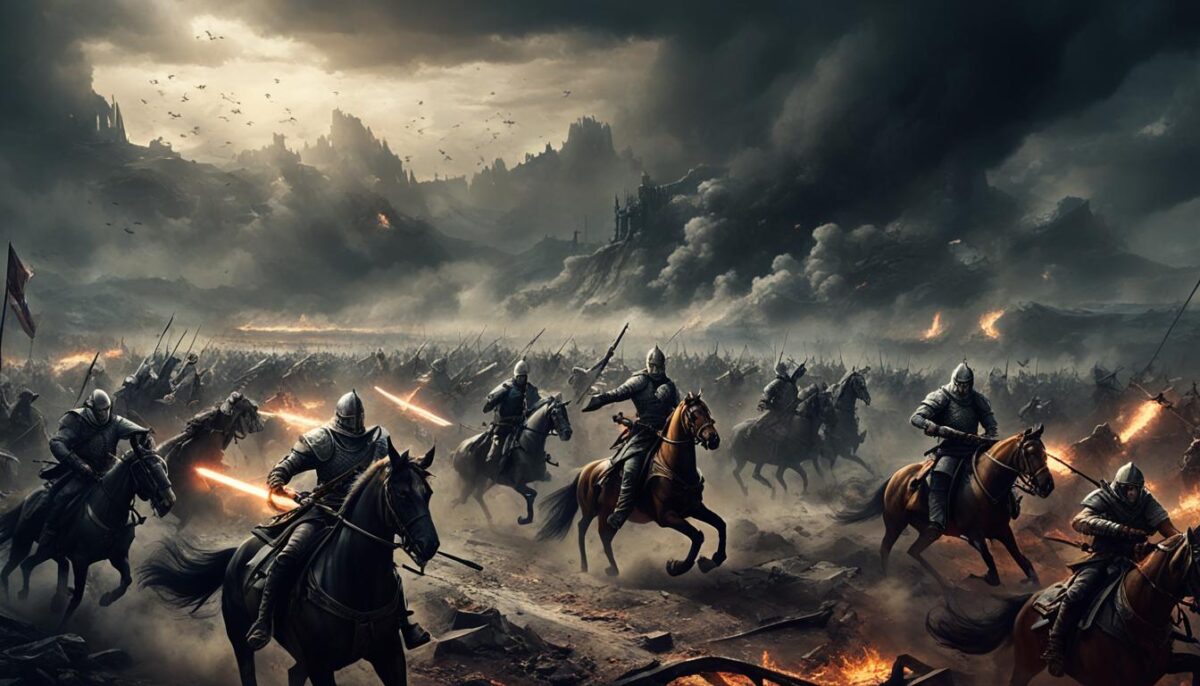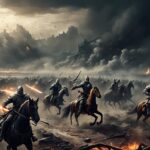Can an old Indian tale unlock deep truths about human nature and the struggle between right and wrong? The Mahabharat Katha is a story that explores its characters, their moral challenges, and the battles they face. By looking closely at this epic, we learn about the complexities of people and the outcomes of our choices.1
The story weaves together themes like dharma (duty/righteousness), power, and family. These themes teach important lessons that touch people all over the world. The Battle of Kurukshetra, a key event, shows us about leadership, war strategy, and making tough choices. These lessons from the Mahabharat Katha are timeless.1
Key Takeaways
- The Mahabharat Katha delves into complex characters, moral dilemmas, and strategic warfare.
- Themes of dharma, power, and family dynamics offer profound moral lessons.
- The Battle of Kurukshetra serves as a strategic blueprint for leadership and decision-making.
- The epic continues to resonate with audiences worldwide, revealing timeless wisdom.
- Intriguing historical evidence suggests the Mahabharat may have roots in reality.
But is the Mahabharat more than myths and legends – could it be a real historical event? Unraveling this epic, we’re faced with a big question: Is the Mahabharat true history, or just a story? As we dive into its depths, we must ponder its true nature.1
The Mahabharat: A Timeless Saga
The Mahabharat is a cherished Hindu epic that has fascinated people for ages. It tells engaging stories full of deep insights and moral struggles.2 It features characters with many layers, touching on the complexity of human nature. They face tough choices, showing us the importance of right conduct, power, and family.3 The epic’s famous Battle of Kurukshetra also teaches leadership and decision-making in challenging times, making it relevant even today.3 The lessons from the Mahabharat Katha are timeless, making it something people all over the world can learn from.
Key Takeaways from the Epic
The Mahabharat is not just a story but a source of wisdom that lasts through time.3 It showcases characters who are both good and flawed, teaching us about leadership and moral duties. The exploration of dharma and karma in the narrative is particularly enlightening.3 Its deep insights have stood the test of time, offering valuable lessons for today’s ethical debates and governance.
The Characters and Their Complexities
The Mahabharat is known for its rich cast of characters, each with their own virtues and flaws.3 Yudhishthira, the elader, faces hard truths, while Duryodhana seeks power out of envy. They show us the complicated nature of right and wrong.3 The Mahabharat Katha is praised for its character development, demonstrating profound truths and appealing to all with its deep wisdom.
Exploring the Characters of Mahabharat
Bhishma was the leader of the Kuru dynasty and a symbol of both goodness and selflessness in the Mahabharat.4 He stayed single and kept his promise to protect Hastinapur’s throne. His story mixes personal sorrow with conflicts in power.
The Complexities of Bhishma
Bhishma faced a tough decision between keeping his vows and meeting his responsibilities as a family elder.4 His decisions continue to affect the epic’s events over time. This complex web teaches us about loyalty and duty.
The Enigma of Karna
Karna lived a life filled with irony, loyalty, and a sorrowful fate.4 His true identity hidden, Karna’s story is a deep tragedy. It shows the longing for belonging and the impact of one’s origins.
The Virtues of Yudhishthira
Yudhishthira is known for his truthfulness and fairness in the Mahabharat.4 His strong belief in dharma often tested his resolve. As the elder Pandava, he fought for what’s right without giving in, showing a rare level of integrity even in tough times.
Themes and Morals in the Mahabharat
Dharma, meaning duty or righteousness, is key in the Mahabharat. It guides characters’ actions and decisions.5 Yudhishthira is called the “lord of dharma” for his wise choices. He tries to balance fate and fulfilling his duties.5 The Mahabharat is rich with lessons on dharma, showing up differently in every part.5 At times, characters find it hard to do what’s asked by society, leading to tough moral choices.
Dharma and Duty
Yudhishthira embodies dharma, facing dilemmas of what’s right and what’s needed for victory.6 Those who follow dharma are praised, the ones breaking its rules are punished.6 The story teaches the importance of courage, truth, and honor for warriors.5 In a key event, Krishna supports Bhima’s act, saying it was right considering his enemies’ actions.
Power and Politics
The Mahabharat is about more than family; it’s about kingdoms, power, and ethics.6 Central figures are from the warrior caste, showing the caste duty’s weight.6 Early dishonest acts hint at terrible fates for those who did them.6 The struggle between the Pandavas and the Kauravas deeply reflects the fight between good and evil.
Family and Betrayal
This epic is as much about family as war, underlining themes of loyalty and deceit.7 It focuses on the Pandavas and Kauravas, giving the story depth.6 Yudhishthira’s story especially shows how right actions can bring peace, yet they can be hard.6 It teaches that achieving true peace sometimes means taking hard paths.
5 The Mahabharat teaches that dharma is key to a good life but applying it can be tricky.6 Krishna shares deep wisdom with figures like Arjuna about doing the right thing.6 It explores ideas like rebirth, cause and effect, and liberation, teaching about life beyond material existence.
The Battle of Kurukshetra: A Strategic Analysis

The Battle of Kurukshetra was a key event in the Mahabharat. It showcased many strategic moves critical to winning the war.8 The Chakravyuh formation, a complex battle strategy, aimed to trap and take down the enemies.8 Success in these plans heavily relied on how well the army’s different parts worked together and the timing of their actions.
Tactical Maneuvers
The Mahabharat highlights several tactical marvels, with the Chakravyuh being a standout.8 Pandava’s Bheema outsmarted Kaurava’s Dhuryodhana against the rules, hitting below the waist in their duel. Using a huge mace called Ghadha, he tested Dhuryodhana’s guard.8 Lord Krishna then secretly helped Bheema by giving rhythmic leg signals, enhancing Mahabharat’s strategic depth.8
The Pandavas used forbidden, unknown strategies, giving them an edge.8 It is interesting that Dronacharya had some special teachings that Arjuna, his favorite, and both Pandavas and Kauravas didn’t know about.8
Leadership in War
Leadership in the Mahabharat was more than commanding armies, focused on right and justice amid war’s chaos.9 The Kaurava side had mighty fighters like Bheeshma and Dronacharya. This favored them.8 Yet, the Pandavas overcame, with help from divine forces aiding their justice cause.8
Krishna’s guidance was vital in the Pandavas’ win.9 Duryodhana led with zeal, yet his lack of leadership loyalty was his downfall.8 The Pandavas’ smart moves highlighted their commitment to righteousness and dharma.8
Is the Mahabharat a Historical Reality?
The story of the Mahabharat sparks intense debate among scholars. They wonder if the myth has real historical events. One key point supporting its reality is the red soil in Kurukshetra. The epic talks about the earth turning red from the blood of the war. Today, the soil still shows this sign, adding weight to the Mahabharat’s historical aspect.10
Traces of Ancient Nuclear Energy
Nuclear traces at Kurukshetra have shocked scholars and deepened the Mahabharat’s mystery. They found signs of nuclear activities, hinting at advanced weapons used during the war. This unusual discovery makes experts consider the use of high-tech warfare in the ancient battle.10
The Enigmatic Influence of the Bhagavad Gita
The Bhagavad Gita, a significant part of the Mahabharat, also attracts scholars. Its deep teachings impressed Oppenheimer, who worked on the atomic bomb. This connection sparks interest in the Mahabharat’s potential history.10
Vitrification — A Sign of Ancient Destruction?
Vitrification evidence, like melted stone, fits the epic’s tales of powerful weapons. This finding aligns with the story of catastrophic tools in the Mahabharat. It pushes experts to consider advanced ancient technology or massive natural disasters.10
Unexplained Existence of Ashvathama
Ashvathama’s story, a warrior surviving the war for centuries, is a captivating mystery. His unproven long life intrigues and inspires the quest for evidence of the Mahabharat’s truth. This tale adds more mystery to the Mahabharat’s possible reality.10
A Tapestry of Historical Places
The Mahabharat describes places later confirmed by archaeology. Sites like Dwaraka and Hastinapura match with the Mahabharat. The Archaeological Survey of India in 2017 even agreed to dig in these places. Such findings give strength to the belief that the Mahabharat is more than just a myth.10
The quest to understand the Mahabharat continues. Its historical puzzle is still not fully solved. With every new find, we get a glimpse of its deep influence and wisdom. Learn more about the debate over the Mahabharat’s historicity.
Mahabharat: An Epic Management Guide

The Mahabharata is an ancient Indian epic with deep lessons in management and leadership.11 It tells the story of the Pandavas and Kauravas, who fight for power and duty.12 Many characters show different qualities of leadership and integrity.
Setting the Stage
This story touches on key management topics like solving conflicts, making decisions, and leading groups.12 Figures such as Bhishma and Krishna teach important lessons in strategic leadership.
Themes and Parallels
The Mahabharata is a rich source of management wisdom. It covers everything from the Bhagavad Gita’s teachings to war strategies.1211 Its lessons on power, family, and ethics are still applicable in today’s corporate world.
Lessons Learned
The epic emphasizes the importance of strategy, forming alliances, and staying flexible.1211 It highlights ethical leadership, offering guidance for leading in the modern business era.
The Enduring Legacy of the Mahabharat
In the tapestry of human experience, past meets present when we discuss the Hindu epic known as the Mahabharat. It shines bright with timeless wisdom. This ancient Indian literature teaches us lessons applicable in today’s world, especially in management and leadership.13 By exploring its stories, we understand its deep meaning and how it still applies today. We learn how its wisdom can guide our paths in leadership.
The Mahabharat has seen many translations and retellings over the years. Thanks to scholars and contemporary writers, its stories have become known worldwide.13 It’s not just in books; from TV shows to movies, its influence is far-reaching.13
It’s not just words or visuals; the Mahabharat has also inspired various performing arts. Traditional Indian arts keep its stories and lessons alive.13 People all over the world still find its wisdom relevant, turning it into a universal symbol of enlightenment.
By diving into the Mahabharat, we understand the timeless depth of Hindu epics. This epic serves as a timeless guide for leadership and understanding the complexity of life. It offers insights into ethical acts, solving conflicts, and seeking a noble goal.
Conclusion
Our journey through the Mahabharata is coming to a close. This Hindu epic has fascinated people for ages. It shares lessons we can use in the fast-moving world of leadership.14
The Mahabharata tells a story that ends sadly, with great loss. It shows us the results of our choices. The tragic deaths and events highlight the depth of human nature.14
In this great tale, we find wisdom that fits our modern world. Characters such as Bhishma, Karna, and Krishna show us different leadership styles. The Mahabharata is like a guide for facing today’s business challenges.14
As we say goodbye to the Mahabharata, we take with us its timeless advice. It helps us understand leadership and life better. The story’s end, where heroes become divine, teaches us about true greatness. It’s about the good we do and what we stand for.14
FAQ
What are the key takeaways from the Mahabharat epic?
The Mahabharat epic brings us complex characters that mirror real human nature. It shows the importance of righteousness, power, and family bonds. The epic’s lesson from the Battle of Kurukshetra is a guide for good leadership, war tactics, and making tough choices in crises.
Who are some of the notable characters in the Mahabharat and what are their complexities?
In the Mahabharat, we meet Bhishma, a symbol of uprightness and self-sacrifice. Karna embodies irony and honor in his life’s struggles. Yudhishthira stands for what is right, always facing moral conflicts.
What are the key themes and moral lessons explored in the Mahabharat?
The Mahabharat dives into themes like doing one’s duty, the quest for power, and the intricate ties within families. It serves important moral lessons on a kingdom’s rise and fall, all driven by power’s allure.
How does the Battle of Kurukshetra demonstrate strategic leadership and warfare in the Mahabharat?
The Battle of Kurukshetra is rich in war strategy, including the famous Chakravyuh tactic. It tests leadership not just in battle but in maintaining fairness and justice amid war’s mayhem.
Is there evidence to support the historical validity of the Mahabharat?
Historical hints back the Mahabharat, like the unique soil of Kurukshetra and ancient warfare signs. The epic’s mysteries and tales of Ashvathama and significant places further fuel historical debates.
How can the Mahabharat offer insights into the world of management and leadership?
The Mahabharat deeply analyzes strategic leadership, tackling conflicts, making decisions, managing groups, and facing ethical challenges. Its teachings from figures like Bhishma and Krishna are still relevant in leadership today.
Source Links
- https://lakin-mohapatra.medium.com/unraveling-the-mahabharata-a-timeless-epic-or-historical-reality-c3b5c0d6a510
- https://chbooks.com/Books/M/Mahabharata
- https://mantrapuja.com/blog/exploring-the-epic-saga-mahabharat-katha-and-its-timeless-wisdom/
- https://www.toolify.ai/ai-news/exploring-the-iconic-characters-of-the-mahabharata-1385357
- https://www.litcharts.com/lit/mahabharata/themes/dharma
- https://www.enotes.com/topics/mahabharata/themes
- https://themandirstore.us/blogs/blogs/mahabharata-the-epic-tale-of-duty-dharma-and-divine-wisdom
- https://www.linkedin.com/pulse/perspective-kurukshetra-war-mahabharata-hindu-praveen-ponmudiyan-q6glc
- https://vocal.media/fiction/the-battle-of-kurukshetra-an-analysis-of-the-mahabharata
- https://www.snopes.com/articles/452170/mahabharata-real-myth-or-both/
- https://www.linkedin.com/pulse/mahabharata-timeless-management-lessons-modern-leaders-yogesh-kantak
- https://medium.com/@tweakandturn/strategic-management-in-the-mahabharata-applying-ancient-wisdom-to-contemporary-challenges-bd9865cf697a
- https://nsbnews.wordpress.com/2023/11/15/mahabharat-an-enduring-legacy-a-timeless-epic/
- https://ancient-buddhist-texts.net/English-Texts/Mahabharata/13-Conclusion.htm

